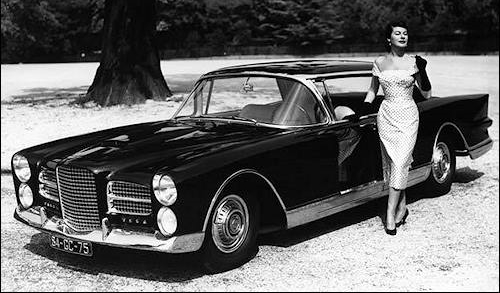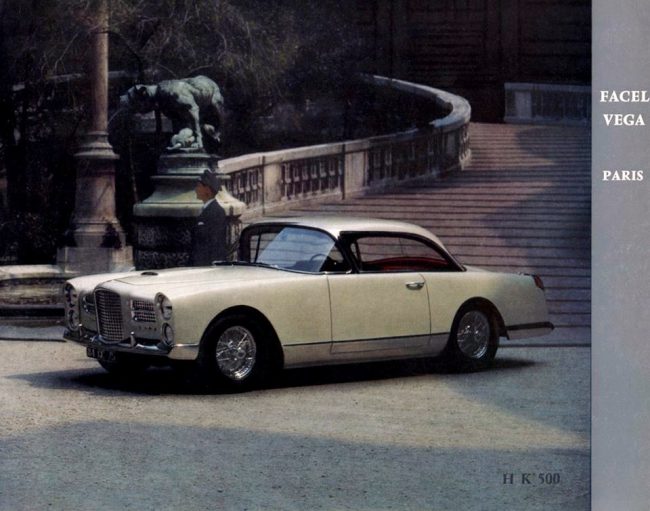In the interest of full disclosure, I must tell you that I am a Francophile. Set a baguette, Brie and Ch. Carbonnieux in front of me and I can die a happy man. Visions of Cote d’Azur or a cafe on Champs-Élysées can bring peace to my tormented mind. And while I acknowledge and regret the national (actually mostly Parisian) reputation for arrogance and condescension, I defend neither it, nor their inexplicable fondness for the comedy of Jerry Lewis. With this in mind, I feel it my obligation to share with you the story of the Facel Vega Excellence, a singular automobile at once quintessentially American and undeniably Gallic.

While Facel Vega—which aside from half its name has no connection to that other Vega, s’il vous plait—had produced automobiles since 1955, the company itself dates back two decades, when M. Jean Daninos, late of Citroën and the military aircraft concern Bronzavia, founded Métallon, a fabricator of kitchen cabinets and sinks and, in 1939, established Forges et Atéliers de Construction d’Eure-et-Loire, (FACEL). The two firms combined and made aircraft engine components during World War II.
Although German forces continued to occupy one of Facel’s two factories after the war was over on French soil, by 1946 Facel had been made whole again. Following a quick reorganization of its facilities, the company resumed production of its original products, and soon started manufacturing automobile bodies for several French constructeurs, including…

Panhard…

Simca…

Bentley…

and Ford of France.
The next few years saw the company expand to four factories that continued to produce car bodies as well as various steel parts and products for France’s aircraft and railroad industries. Daninos realized that with the war over, his automotive clients would once again have the capacity to build their own bodies, and thus decided to produce his own complete car under the Facel brand.

The first all-Facel automobile, the “Vega”, or FV-1 coupe, made its debut at the 1954 Paris Auto Salon. Its coachwork may have been distinctly European, but to put it in motion, a 5.4L Hemi V8 was sourced from Chrysler Corporation and mated to either a two-speed PowerFlite automatic transmission or a Pont-à-Mousson four-speed manual box.
The FV-1 was followed by the 1956-58 FSV and the 1959-61 HK 500, both of which retained the Vega’s pillarless coupe body style and Chrysler power.

The final HK 500 iteration (pictured) featured a 6.3L, 360 hp version that could propel the somewhat blocky, two-ton coupe to 60 mph in 8.5 seconds— quite a respectable figure at the time.
Facel Vega would introduce several new coupe and convertible models until the company shuttered its factories in 1964, but now we shall pause our history lesson and turn to the subject of this article, the 1958-61 Facel Vega Excellence.

Excellence, indeed! Previewed at the 1956 Paris auto show (to tremendous interest from press and public alike), the first Excellence production cars left the factory in 1958. This was an automobile like nothing that had come from Facel Vega before: a big (206.1″), four-door luxury sedan that featured such contemporary styling elements as tailfins, a wraparound windshield and a pillarless greenhouse—it was all quite commonplace, oui?

Mais non! For beneath that handsome greenhouse were suicide doors that, when opened, revealed the rather stunning lack of a conventional center post; instead, the doors latched into two round, sill-mounted receivers. Indeed, one must give due credit to the Excellence engineers who managed to maintain structural integrity without the benefit of a traditional structural member.


Daninos didn’t want to make a four door car, but ‘people asked me for four doors’. He regarded the Excellence as a mistake but once built, wanted it to be the French President’s car. President de Gaulle rebuffed the notion, reportedly put off by the car’s American engine and transmission; however, the Excellence apparently appealed to Mme. de Gaulle, who used one as her personal transport. An additional 12 Excellences were sold to French ambassadors around the world.

Its prestige was easy to understand: The Excellence cost four times as much as the luxurious Citroen DS—but at least some of that money went where it showed. The interior was nothing less than sybaritic; in addition to some of the finest leather upholstery this side of Crewe, it featured a center-console makeup kit, comprising a chromed brush-and-comb set and two perfume atomizers, for rear-seat passengers.

There was full instrumentation on board, some of which monitored the activity of the 6.3L, 360 hp Chrysler Hemi beneath the hood. Chrysler stopped offering the Hemi for 1958, but Facel continued to use the engine until their supply ran out, in late 1958. The switch was made to Chrysler’s big-block 5.9L “Wedge” engine, also rated at 360 hp. Both engines could be mated to either a Pont-a-Mousson four-speed manual transmission or to Chrysler’s TorqueFlite automatic. A mere 11 first-generation Excellences were produced, the final one going to American actress Ava Gardner.

The change in engines defined the second-generation Excellence, internally designated EX1. Built from October 1958 to July 1961, this was the most-produced version of the Excellence, at 137 finished units. Although front disc brakes were now available for the first time, ultimately only five cars were fitted with them.

The third and final iteration of the Excellence, the EX2, arrived in July 1961. The significantly face-lifted EX2 had lost the wraparound windshield of its predecessors and now wore much shorter tailfins. Once more, a 6.3L Chrysler V8, this time rated at 390 hp, provided power. In retrospect, the restyle seems a bit puzzling; the new model’s appearance wasn’t all that different from the car it replaced, and ultimately only eight EX2s would be produced.

In 1959, a New York-based syndicate was toying with the idea of a Packard revival (a perfectly awful idea that nevertheless seems to surface every few years), and was approached by Daninos, whose proposition was to bring traditional Packard styling cues and the Packard V8 to the Excellence, which would then be rebadged and sold as a Packard at Studebaker-Packard dealerships. The problem was, S-P was already the sales channel for another luxury import called Mercedes-Benz. The powers at Daimler-Benz quickly expressed their displeasure to S-P president Harold Churchill, pointing out that Facel could not come close to providing S-P with quick cash infusions when needed. Churchill, a pragmatic man who could add and subtract, quickly abandoned the Excellence-as-Packard idea before a prototype could be built.
Facel Vega scrambled to survive by introducing the Faciella coupe, which used a Facel-engineered engine based on an Alfa Romeo design. In the finest Italian tradition, it proved so trouble-plagued that Facel soon dropped it in favor of a Volvo-sourced engine; however, the damage was done, and it destroyed what remained of the brand’s reputation. In July 1962, Facel was forced into receivership. Operations were allowed to continue under court oversight.

Facel’s borrowed time ran out on Halloween Day 1964, when the company closed operations permanently after having produced some 2,900 cars. Although it lived only a decade, the Facel Vega nameplate continues to attract interest among auto historians, classic car enthusiasts, and in thriving Facel Vega clubs in America, Germany, the UK, Holland and of course, France. The marque’s roster of owners boasts such names as Pablo Picasso, Ringo Starr, Stirling Moss, Frank Sinatra and Dean Martin, as well as several kings, heads of state, and ambassadors. Today, a 1958 Condition-3 Excellence commands $165,000, and a Condition-2 example upwards of $200,000–providing you can find one for sale.
Writing this post involved cross-checking five different online and print sources; in the process, I learned more about Facel Vega that I’ll ever need to know, and that started me thinking: why the trouble? Why do people like us spend valuable time researching such obscure and often forgotten cars with the same passion that many other guys have for baseball statistics or the discographies of rock bands? Here’s why: Because it matters. Maybe not to everyone, but to those of us who look at an old car, even one produced in the millions, not so much as a piece of metal but as a part of history–a history punctuated with the oddball, the ahead-of-their-time, the timelessly beautiful and the dreadfully ugly; in other words, those that surprise and delight and make car life a lot more interesting. Depending on whom you ask, the Excellence is any or all of these things, and thus worthy of a place at our table.


























9 Comments
The ability to fabricate by hand such elaborate shapes was quite impressive. When Bristol brought the body manufacturing in house, a necessity because they were no longer building in sufficient quantities to order out, the shape of the cars had to be simplified. Similarly Rolls Royce when they brought in body making inhouse for the Arnage/Silver Seraph.
A tie up with an American manufacturer for powerful engines and convenience features seems a requirement. Even the big guys did it, MB with Chrysler controls on GM air conditioners and their automatics derived from Borg-Warner ne Ford.
France seemed such a natural place for ultra high end cars. If the requirement for a Town Car to shuttle around the Paris night life wasn’t enough. The virtual ban on cars over 2 liters would seem to push a few not quite as rich buyers upmarket. They had lost an empire and been battered by two world wars and at some point the socialists do bleed dry the old wealth. Thanks Tony.
Lovely cars .
A Show & Shine I like to attend occasionally has two of these show up .
-Nate
Welcome to Tom Klockau’s blog, with an occasional guest post by Jack Baruth.
What can i say? He’s more popular than I am… and i’m here to give the people what they want!
You are lucky to have Tom and now Tony. If this blog has to go away because of your new gig, I hope we won’t lose Tom’s offerings. Of course it would be easy and not expensive to start his own word press site. If he doesn’t want to do that, I would welcome him at my stamp collecting site, the-philatelist.com. I publish 5, 600ish word articles a week about individual stamps from my collection that his readers would have to sift through to find Tom’s stuff. It might be worth doing if the alternative is Tom losing his writing outlet. Have Tom drop me an email if he is interested.
I’m so glad Facel got covered. The FV4/HK500 has been one of my favorite classic auto shapes. It’s cool to see how the FV’s designs appear to be bridge between that era of Bentleys and, say, the fintail Benzes — convergent evolution, if you will.
My family from MN owned a black Facel Vega. I can remember how beautiful the inside of the car was as a kid. I loved the suicide doors too.
Throughout the late 1970’s/early 80’s I used to go to a cinema, The Charles, in Baltimore. (Still very much in operation.) I parked in a multi-level lot across the street. I recall that for years a Facel Vega remained parked in a corner spot, appearing abandoned, with flat tires and covered with bird poop. I was an underpaid medical resident, and although I was struck by the beauty of this machine, I didn’t realize the potential value of what I was looking at. I have no idea whatever became of it. If anyone knows, I’d love to hear from them.
“In 1959, a New York-based syndicate was toying with the idea of a Packard revival (a perfectly awful idea that nevertheless seems to surface every few years)”. Wow, this is definitely ONE MAN’S opinion. I can think of nothing more wonderful than to see the glorious Packard nameplate back on the world’s highways. A legendary name and prestigious history that the 10 year old brand Facel-Vega couldn’t touch with a zillion foot pole!